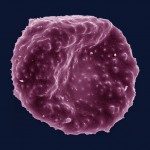Link to Pubmed [PMID] – 1330897
Immunology 1992 Oct;77(2):251-5
The primary IgM response of murine B lymphocytes against red blood cell-bound antigens can be induced by incubating antigen-reactive B cells either with the lymphokines interleukin-1 (IL-1) and IL-2 together with the nucleoside cAMP, or by the addition of antigen-specific helper T cells. The reactivity of B cells is strongly influenced by the T-cell lymphokine IL-2. IL-2 inhibits the cyclic adenosine 3′,5′-phosphate (cAMP)-dependent B-cell response when it is allowed to act on the cells prior to cAMP. On the other hand, if IL-2 acts on B cells together with or after cAMP, it synergizes with the nucleoside and enhances the immune response. A similar effect of IL-2 is observed in the T-cell-mediated activation of B cells. If IL-2 is present before helper T cells interacted with B cells, it inhibits antibody production. The inhibitory IL-2 effect is reversed by the simultaneous addition of exogenous cAMP. The finding supports the hypothesis that Ia ligation by T cells results in B cells in the elevation of cAMP which acts as an important second messenger in B cells. The antagonism between cAMP and IL-2 was also examined in the pre-B-cell line 70Z/3. The nucleoside is highly toxic to 70Z/3 pre-B cells and a majority disintegrates within hours of exposure to the nucleoside. The surviving cells undergo phenotypic differentiation expressing surface Ig kappa chains and major histocompatibility complex (MHC) class II molecules, and increase the expression of IL-2 receptor (R). The phenotypic differentiation requires the presence of IL-1. IL-2 inhibits both of these B-cell responses to cAMP, the IL-1-independent cell death, and the IL-1-dependent phenotypic differentiation.


